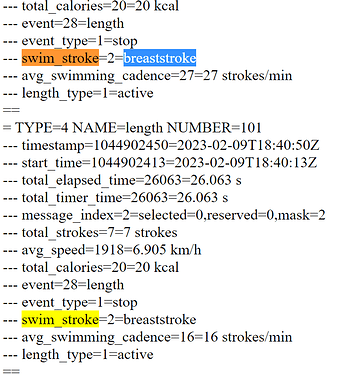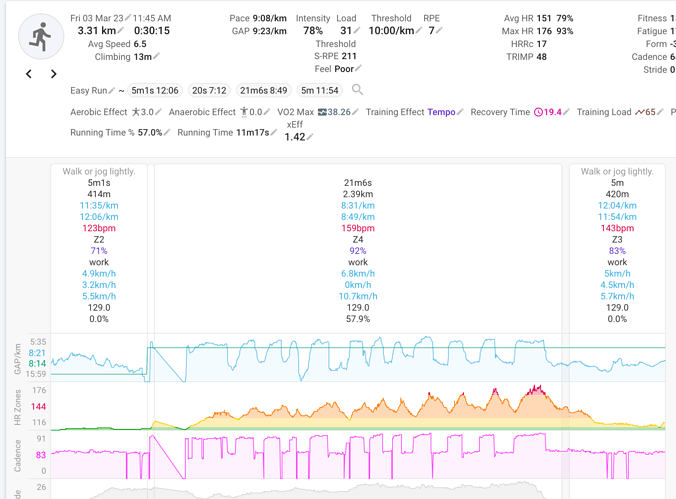This is awesome work!!! Thank you David!
This is amazing 
Having custom code is setting intervals.icu apart from the competition.
Potentially there could be a forum thread with a library of useful code.
Thank you, looks awesome !
Is “VAM” an available stream ?
No you would need to compute that from “fixed_altitude” (altitude with elevation correction applied if needed and gaps interpolated).
Hi @david,
Is it possible to add core_temperature as a field? If so, what script would I need to add to get this to work?
Thanks
Sure. I added a new public interval field “Average Core Temp” and added that to your interval fields. You should see it in the “Fields” list. The script looks like this:
temp = streams.get("core_temperature").data
tot = 0
c = 0
for (let i = interval.start_index; i < interval.end_index; i++) {
let v = temp[i]
if (v) {
tot += v
++c
}
}
c ? tot/c : null
I also added “Max Core Temp” if that is what you are after:
temp = streams.get("core_temperature").data
max = 0
for (let i = interval.start_index; i < interval.end_index; i++) {
let v = temp[i]
if (v > max) max = v
}
max > 0 ? max : null
Has anyone figured out if this can be used to get di2 gear info ?
Hi @david
I have created Interval Field for swimming: “Interval Swim Stroke” with select list. Is it possible to map fit file for this specific stroke type ? I can find it in file at the end of each inerval:
If so, what script should I add to get this to work?
That is on the length messages and there isn’t a way to get data out of those onto the intervals yet.
I have made custom fields called “Running time” and “Running time %”, similar to the run/walk detection in Garmin. Thought some of you might like it 
There are fields both for the activity as a whole, and for each interval.
Here’s what it looks like:
It defines running as anything over a 60 cadence, and walking as anything over a 10 cadence. It will also ignore any data during the warmup and cooldown periods defined for your running activity.
The running time calculated is usually a little lower than the one shown by Garmin - not sure why but its usually <1m of difference.
@david I’m trying to extract Stryd average Vertical Oscillation out of fit file data for my intervals and have been unsuccessful so far. Any advice?
You will be able to do that when I finally find time to complete support for mapping custom fields from records to activity traces. You will need to create a trace for it and then a custom activity/interval field to calculate the average.
Dear all,
I am trying to add an interval field which should be apparently pretty simple:
(Work above FTP/Total Work*100) > its simply the percentage of W>FTP to the Wtot for that interval.
I have found the “joules_above_ftp Integer” on the script page, but I must confess, my scripting-skills are pretty poor 
Any help is much appreciated.
thanks
alfred
@david:
brief question to your “All Work >FTP” field:
it is described as “…This measure includes the below the line portion when operating at or above FTP.”
Does this mean that power AT FTP is also accounted for (i.e. FTP 250W > the script also calculates when working at 250W and not starts at 251W as the Work>FTP would do?).
And what means “…below the line portion…”? Does it also calculate 249 or 248, which is, by definition below FTP. Is there any trade-off in the script (e.g. if power is below FTP for xxx seconds > then calculate > else not).
Sorry for my simplified coding language, hope the question is clear enough.
best
alfred
There are 2 possibilities:
- You only take the Work that has been done at or above FTP and only that portion
- You take all Work done when intensity is equal or above FTP
The script does “if (w >= ftp) {” so yes work done at FTP counts. I think this script will do:
{
interval.joules_above_ftp * 100 / interval.joules
}
thank you David, script works as required, and also @MedTechCD for stepping in.
re to (w>=ftp): this makes a significant difference compared to (w>ftp), in the example below 35 vs 215kJ

Have to reconsider on whether 1Watt up or down can make such a difference. But then again over 3h…
cheers
alfred
hi again, sorry a little too late yesterday evening to think clear 
Soon became clear afterwards that “All Work>FTP” calculate ALL power*t, whereas “W>FTP” use the typical Wbal calculation where W=(P-FTP)*t.
The former is obviously much higher.
cheers
alfred
That’s what I wanted to point out with this remark 
yes, with hindsight it is clear and thank you for this. As an advocate for the CP-concept I haven’t considered to use all work at first sight…

